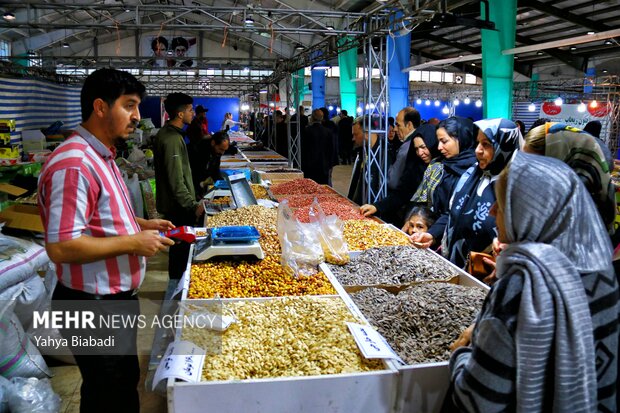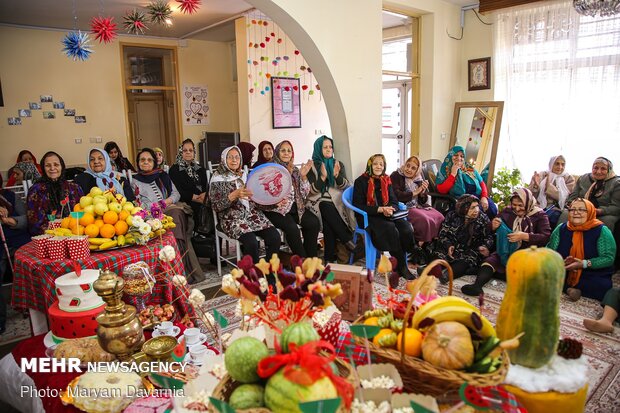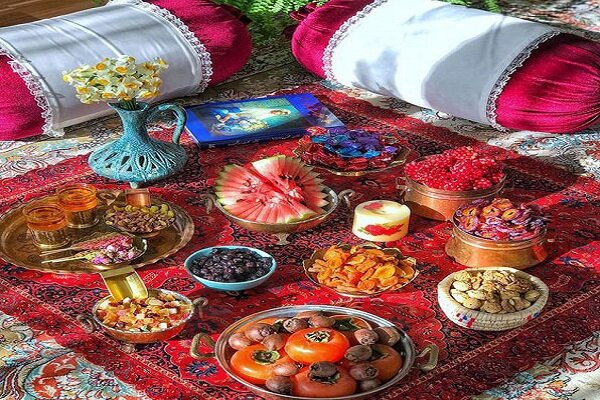An ancient Iranian festival that basically celebrates the coming of the winter solstice and the longest night of the year for centuries is Yalda Night (or Shab-e Yalda; also, Shab-e Chelleh). It refers to a time between the sunset of autumn�s last day (the 30th of Azar in the Iranian calendar equal to the 21st of December) and the sunrise of the first day of winter (the 1st of Dey in the Iranian calendar equal to the 22nd of December).
It is considered as one of the holy nights and one of the most important festivities in ancient Iran and officially entered the official calendar of the ancient Iranians from 502 BC during the time of Darius I, commonly known as Darius the Great.
Yalda Night, both before and after Islam, has a special place in Iranian culture and has always been considered a motivation for gathering close and distant relatives. The festivities that take place on this night are an ancient tradition.
Since days get longer and nights to get shorter in winter, Iranians celebrate the last night of autumn as the renewal of the sun and the victory of light over darkness.

Yalda night is a long-standing tradition that has long been considered important by Iranians. In ancient times, darkness was considered a sign of the devil, so on in the night of Yalda, which is the longest night of the year, the Iranians lit fires to protect themselves from evil forces due to the light of fires.
Like Iran, Central Asian countries, including Afghanistan, Uzbekistan, Turkmenistan, Tajikistan and some Caucasian states like Azerbaijan and Armenia, and some parts of Pakistan, India, and Kashmir which share the same tradition, celebrate Yalda Night.
Iranians' traditions and customs on Yalda night are different from other countries. On the eve of Yalda Night, indescribable passion arises among Iranian families as they want to prepare themselves for this night.
 A family sits on the floor around the Korsi during the 'Yalda Night' celebration
A family sits on the floor around the Korsi during the 'Yalda Night' celebrationYalda Night customs have not changed much over time.
If we review the history of Yalda, we can find that in ancient times people used to gather around the fire and celebrate the night. Around the past thirty or forty years, Iranians used to sit around a Korsi (a type of low table found in Iran, with a heater underneath it, and blankets thrown over it), and nowadays, people are using heaters and other kinds of heating devices in their houses. Yalda is now celebrated by Iranians in a form of an overnight family gathering.
On Yalda Night, people gather in groups of friends or relatives usually at the home of grandparents or the elderly to celebrate the longest night of the year. As storytelling is an entertaining tradition of Yalda Night, the elders entertain the others by telling them tales and anecdotes.
Reading Shahnameh and poems from Divan-e-Hafiz is the other Iranian tradition in this ancient Iranian festival. Each of the members of a family or a group of friends makes a wish-while keeping it a secret- and randomly opens the Divan-e-Hafiz; then the eldest member of the family or friends reads the randomly selected poem loudly. Since the poem is believed to be the interpretation of the wish and the way it would come true, it is fun to interpret the poem and guess the wishes others make.
 People in Kermanshah province of Iran getting ready for 'Yalda Night'
People in Kermanshah province of Iran getting ready for 'Yalda Night'One of the most attractive rituals of Yalda night is its food, fruits, and snacks.
Iranian families usually prepare a sumptuous dinner as well as buy nuts and a variety of fruits, most commonly watermelon and pomegranate. Every city and culture considers special food to celebrate Yalda night.
Fruits, especially red fruits play important role in Yalda's delicious part. The red color of these fruits is a symbol of the sun.
 Pomegranate�main fruit of 'Yalda Night'
Pomegranate�main fruit of 'Yalda Night'Pomegranate is the main fruit of Yalda Night. The ancients considered pomegranate to be the fruit of fertility and blessing. Pomegranate is also considered as a symbol of happiness and the sun because of its red color. It has been known as a sacred fruit since ancient times.
Watermelon, like pomegranate, is a special fruit for Yalda Night. But isn't it weird to eat watermelon on a cold day?
We all know that watermelon is a summer fruit; so watermelon, in addition to its red color, is a symbol of the sun and reminiscent of summer heat. It was believed that if they eat some watermelon this night, they will be safe from cold and disease throughout the winter.
Other Yalda fruits include autumn fruits. Fruits such as oranges and citrus fruits, apples, persimmons, pears, and even pumpkins were also used in Yalda Night.
On this night, snacks and nuts for Yalda night are more important than dinner. Nuts such as pistachios, walnuts, almonds, and hazelnuts are the main components of nuts for Yalda night. Dried figs and berries are also can be seen among the delicious part of this night.

Yalda Night ritual is held in different cities of Iran based on the city's culture and geography, each of which has its own charms; However, some of them have been forgotten and only a memory of them remains.
An old custom still rehearsed in eastern parts of the country (Khorasan) is the preparation and consumption of "Kaf", which is a sort of sweet that looks like foam. Another custom of specific parts of Iran and Khorasan on the night of Chelleh is related to young engaged couples.
Another ceremony that was held this night in Khorasan was the ceremony of Shahnameh, where elders of the party were engaged in songwriting and reading Shahnameh.
In Tabriz, street musicians known as �Ashiq� walk around neighborhoods while singing, playing music, and telling legends and stories.
The beauty of Yalda in the Lorestan Area starts right after the sunset when young people would go on the neighbors� rooftops and start singing the �Shov-e Avval-e Q?reh� song, where they would hang a scarf from the rooftop of the neighbor�s house, asking them for treats.
 �Yalda� celebration ceremony in Day Care Center in Bojnourd
�Yalda� celebration ceremony in Day Care Center in BojnourdZanjan is among the few places where �Korsi� has still practical usage; and wherever there is a Korsi, there will be a memorable gathering. On Yalda, local people serve their own local sweets including the famous window-shaped pastries and baklava.
In Sanandaj, the capital of Kordestan Province, dolma and sangak bread is prepared for Yalda. Each year, as agreed between the families, the ceremony takes place in a different house.
As Yalda Night and its traditions are so interesting, it was officially added to Iran�s List of National Treasures during a special ceremony in 2008.
This year, due to the global epidemic of coronavirus, a different situation prevails for all families on Yalda night.
In this regard, the authorities have asked the people to hold the ceremony differently this year and to refrain from going to each other's houses in order to prevent further transmission of the coronavirus.
Iranian people have been also advised to stay at their homes and celebrate this ritual virtually this year through voice and video calls.
By MEHR�











